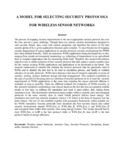| dc.description.abstract | A MODEL FOR SELECTING SECURITY PROTOCOLS
FOR WIRELESS SENSOR NETWORKS
Abstract
The process of mapping security requirements to the most appropriate security protocol has over
the time proved a great challenge. Though there are various security mechanisms designed to
curb security threats, they come with various properties and therefore the choice of the best
security protocol for a given application becomes quite complex. To ease the process of mapping
security requirement of sensor applications to security protocol, security environments for WSNs
have been defined formally. There are numerous WSNs applications being developed day to day,
ranging from simple environmental monitoring e.g. collecting of temperatures in an agricultural
farm to complex applications like for monitoring battle field. Therefore this research dissertation
objective was to enable selection of best security protocol that falls under a certain security class
for the various existing WSNs applications and applications to be developed in the future. The
research endeavored to identify and evaluate the security protocols that are practically used in
WSNs and to identify the best tool to be used in simulation process, and finally to validate
selection of security protocols. WSNs have become a hot area of research especially in issues of
security, routing, systems hardware design and data management. This research contributes to
the area of security by focusing more on selection of security protocols so as to meet the security
requirements of WSNs applications at the same time ensuring the sensor networks lifetime is
extended as long as possible. There are different methods for evaluation of WSNs security, in
this research simulation methodology was chosen based on the fact that you can generate reliable
results in less time, in addition the simulation tool used is open source, thus cutting down
simulation costs. This dissertation introduced energy metric within a security class and compared
protocols in the same security class to check which protocol utilizes lesser energy. The
simulation tool used was network simulator version 2.35 which at the time of research was the
latest release. The ns2.35 was installed together with mannasim framework, which extends ns2
for WSNs simulation. Security protocols were classified into four security classes also called
security environments namely WSN_Env_A, WSN_Env_B, WSN_Env_C and WSN_Env_D
and compared them within their security class using energy metrics; The results showed that in
class WSN_Env_A LiSP is the best protocol while in WSN_Env_B class LLSP is the best
protocol based on energy efficiency.
Keywords: Wireless sensor Networks, Security Class, Security Protocols, Simulation, Sensor
nodes, Security Services | en_US |

